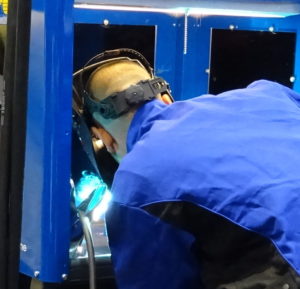
Anderson: FCA mandates destructive test welds
By onBusiness Practices | Education | Repair Operations | Technology
FCA requires collision repairers to perform destructive test welds prior to attempting any welding on a customer’s car, Collision Advice CEO Mike Anderson pointed out in a Friday webinar.
Anderson said every OEM he works with requires the test welds.
“This scares me a ton,” he said, apparently questioning whether shops were doing them.
He cited language from the 2017 Chrysler Pacifica body repair manual demonstrating the test weld mandate.
“Weld coupons identical to the repair situation need to be created to help set up the welding equipment and weld process,” FCA writes. “These coupons then should be destructively tested to ensure proper quality welds are being made.”
This extends to squeeze-type resistance spot spot welds, according to another passage cited by Anderson.
“With advancements in equipment technologies, such as computer program controlled and inverters, STRSW is not restricted to light gauge sheet metal any longer. Heavier gauges of high strength and coated steel, currently used in vehicle structures, can now be welded in the field, providing destructive testing is performed on each combination. This is to ensure quality welds are being maintained.”
“We need to make sure that we’re doing that,” Anderson said.
The repair procedures also describe what size of nugget should be produced in the testing with a “Minimum Weld Nugget Requirement Chart.”
“Keep in mind that different material coatings, coating thickness, material thickness, and joint configurations have a direct impact on nugget size,” FCA writes.
Anderson said he didn’t care about whether destructive test welds were included or not-included procedures. (They’re not, according to Anderson.) All he cared about was “Are you doing it?”
FCA calls verifying weld quality the “most important” aspect of technician training. It also states that training is “required.”
As with any equipment, proper training is required, and in the case of welding equipment this is no exception. The goal of automobile facilities and technicians is to restore the vehicle to its OEM condition.
Training must be considered a two-fold process:
• The technician must be well versed in how the equipment operates, how adjustments are made and what effects those adjustments have on the weld. The technician must also clearly understand the maintenance of the equipment and the impact of poor maintenance on welds and equipment longevity.
• The second and most important, aspect of the training, is weld quality confirmation. Destructive testing of weld coupons must be performed to ensure the minimum weld size is created. Physical appearance of the weld is not enough to determine the quality of the weld. Additionally, poor welds may also reduce the durability, or quality , of the repaired vehicle in time.
It is required that technicians have received training regardless of the welding equipment or method they utilize. Both training in the specific field of welding, and the particular equipment, are necessary to ensure safe, durable, quality welds are obtained. (Minor formatting edits; emphasis FCA’s.)
Asked about how to perform destructive weld testing, Anderson said a welding supply company should be able to provide the necessary coupons. (Remember that these need to be identical to the original; FCA demands technicians have “an accurate material thickness gauge” to measure the substrates and also describes using a “venire caliper” to measure a nugget.)
FCA body, chassis and paint global service lead Dan Black also mentioned the idea of a test weld for squeeze-type resistance spot welding including the adhesive required in the actual vehicle joint by FCA.
That’s an additional time factor a shop or insurer would have to take into consideration, particularly if it takes more than one destructive test weld to dial in equipment so the customer gets a safe and proper repair.
“Prior to making repairs with STRSW, weld coupons must be created for testing,” FCA wrote in the Pacifica body repair manual. “The test joint must be an exact duplicate of the original joint, including layering and adhesive application. The testing is required to ensure the repair restores the vehicle to its originally produced condition using the minimum weld nugget requirement chart.”
FCA has required such test welds for more than a decade at least — a 2006 Weld Bonding Guide back when the company was still DaimlerChrysler contains similar destructive testing instructions to the body repair manual for the 2017 Pacifica — including applying and adhesive for STRSW test welds.
If you haven’t been doing destructive tests all that time, it’s time to get with the program.
The webinar also noted that FCA bans shops from welding within 12 inches of any electrical component, which Anderson said would turn into an “antenna.” The act of welding creates an electromagnetic pulse which could be detrimental to these parts, he said. This might mean that the act of replacing a quarter panel demands a shop remove elements like a wiring harness or airbags located a foot from the weld point, he said.
More information:
Free FCA Mopar Repair Connection site
Paid FCA Mopar Tech Authority site
“Learn to Research; Research to Learn (Using FCA’s Tech Authority)”
Collision Advice and FCA, March 23, 2018
Images:
A man tries out ProSpot welding equipment at NACE 2017. (John Huetter/Repairer Driven News)
An example of a destructive test weld from the auto body repair manual for the 2017 Chrysler Pacifica. (Provided by FCA)

